Deck 8: Linear Systems and Matrices
Question
Question
Question
Question
Question
Question
Question
Question
Question
Question
Question
Question
Question
Question
Question
Question
Question
Question
Question
Question
Question
Question
Question
Question
Question
Question
Question
Question
Question
Question
Question
Question
Question
Question
Question
Question
Question
Question
Question
Question
Question
Question
Question
Question
Question
Question
Question
Question
Question
Question
Question
Question
Question
Question
Question
Question
Question
Question
Question
Question
Question
Question
Question
Question
Question
Question
Question
Question
Question
Question
Question
Question
Question
Question
Question
Question
Question
Question
Question
Question

Unlock Deck
Sign up to unlock the cards in this deck!
Unlock Deck
Unlock Deck
1/150
Play
Full screen (f)
Deck 8: Linear Systems and Matrices
1
Solve using any method. 
A)
B)
C)
D)
E) inconsistent

A)

B)

C)

D)

E) inconsistent

2
Find the sales necessary to break even (R - C = 0) for the cost C of producing x units and the revenue R obtained by selling x units. (Round to the nearest whole unit.) 
A) 254 units
B) 254 units or 281 units
C) 272 units
D) 281 units
E) no real solution

A) 254 units
B) 254 units or 281 units
C) 272 units
D) 281 units
E) no real solution
281 units
3
Evaluate the expression. 
A)
B)
C)
D) not possible
E)

A)

B)

C)

D) not possible
E)


4
If possible, find AB. 
A)
B)
C) not possible
D)
E)

A)

B)

C) not possible
D)

E)


Unlock Deck
Unlock for access to all 150 flashcards in this deck.
Unlock Deck
k this deck
5
Evaluate the expression. 
A)
B) not possible
C)
D)
E)

A)

B) not possible
C)

D)

E)


Unlock Deck
Unlock for access to all 150 flashcards in this deck.
Unlock Deck
k this deck
6
Applying Kirchhoff's Laws to the electrical network in the figure, the currents I1, I2, and I3 are the solution of the system  Find the currents.
Find the currents. 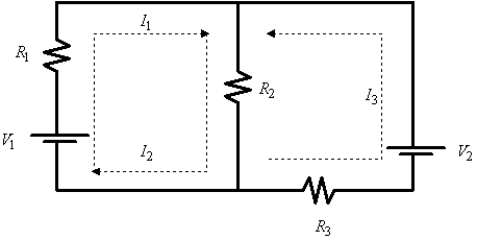

A)


B)


C)


D)


E)


 Find the currents.
Find the currents. 

A)



B)



C)



D)



E)




Unlock Deck
Unlock for access to all 150 flashcards in this deck.
Unlock Deck
k this deck
7
Solve the system by the method of elimination. 
A)
B) inconsistent
C)
D)
E)

A)

B) inconsistent
C)

D)

E)


Unlock Deck
Unlock for access to all 150 flashcards in this deck.
Unlock Deck
k this deck
8
During one performance of a local arts council's presentation of Fiddler on the Roof, the box office sold 239 tickets and collected $1389. If adult tickets sold for $10 and children's tickets sold for $3, how many of each type of ticket were sold?
A) adult tickets sold = 92; children's tickets sold = 156
B) adult tickets sold = 143; children's tickets sold = 96
C) adult tickets sold = 139; children's tickets sold = 92
D) adult tickets sold = 92; children's tickets sold = 139
E) adult tickets sold = 96; children's tickets sold = 143
A) adult tickets sold = 92; children's tickets sold = 156
B) adult tickets sold = 143; children's tickets sold = 96
C) adult tickets sold = 139; children's tickets sold = 92
D) adult tickets sold = 92; children's tickets sold = 139
E) adult tickets sold = 96; children's tickets sold = 143

Unlock Deck
Unlock for access to all 150 flashcards in this deck.
Unlock Deck
k this deck
9
Solve using any method. 
A)
B) inconsistent
C)
D)
E)

A)

B) inconsistent
C)

D)

E)


Unlock Deck
Unlock for access to all 150 flashcards in this deck.
Unlock Deck
k this deck
10
Find the equilibrium point of the demand and supply equations. (The equilibrium point is the price p and number of units x that satisfy both the demand and supply equations.) Demand
Supply

A)
B)
C)
D) inconsistent
E)
Supply


A)

B)

C)

D) inconsistent
E)


Unlock Deck
Unlock for access to all 150 flashcards in this deck.
Unlock Deck
k this deck
11
Solve the system by the method of substitution. 
A) (3, 2)
B) (2, 3)
C) (2, -3)
D) (-3, 2)
E) (-2, 3)

A) (3, 2)
B) (2, 3)
C) (2, -3)
D) (-3, 2)
E) (-2, 3)

Unlock Deck
Unlock for access to all 150 flashcards in this deck.
Unlock Deck
k this deck
12
The currents in an electrical network are given by the solutions of the system  where I1, I2, and I3 are measured in amperes. Solve the system of equations using matrices.
where I1, I2, and I3 are measured in amperes. Solve the system of equations using matrices.
A) I1 = 3, I2 = 3, I3 = 6
B) I1 = 4, I2 = 2, I3 = 6
C) I1 = 4, I2 = 6, I3 = 2
D) I1 = 3, I2 = 3, I3 = 7
E) no solution
 where I1, I2, and I3 are measured in amperes. Solve the system of equations using matrices.
where I1, I2, and I3 are measured in amperes. Solve the system of equations using matrices.A) I1 = 3, I2 = 3, I3 = 6
B) I1 = 4, I2 = 2, I3 = 6
C) I1 = 4, I2 = 6, I3 = 2
D) I1 = 3, I2 = 3, I3 = 7
E) no solution

Unlock Deck
Unlock for access to all 150 flashcards in this deck.
Unlock Deck
k this deck
13
An object moving vertically is at the given heights at the specified times. Find the position equation  for the object. At t = 1 second, s = 421 feet
for the object. At t = 1 second, s = 421 feet
At t = 2 seconds, s = 358 feet
At t = 3 seconds, s = 263 feet
A)
B)
C)
D)
E)
 for the object. At t = 1 second, s = 421 feet
for the object. At t = 1 second, s = 421 feetAt t = 2 seconds, s = 358 feet
At t = 3 seconds, s = 263 feet
A)

B)

C)

D)

E)


Unlock Deck
Unlock for access to all 150 flashcards in this deck.
Unlock Deck
k this deck
14
Determine whether the matrix is in row-echelon form. If it is, determine if it is also in reduced row-echelon form. 
A) row-echelon form
B) row-echelon form and reduced row-echelon form
C) neither

A) row-echelon form
B) row-echelon form and reduced row-echelon form
C) neither

Unlock Deck
Unlock for access to all 150 flashcards in this deck.
Unlock Deck
k this deck
15
If possible, find 3A - 2B. 
A)
B)
C) not possible
D)
E)

A)

B)

C) not possible
D)

E)


Unlock Deck
Unlock for access to all 150 flashcards in this deck.
Unlock Deck
k this deck
16
Use matrices to solve the system of equations (if possible). Use Gaussian elimination with back-substitution or Gauss-Jordan elimination. 
A) x = -4, y = -2, z = 5
B) x = -2, y = 4, z = -5
C) no solution
D) x = -4, y = 2, z = 5
E) x = 4, y = 2, z = 5

A) x = -4, y = -2, z = 5
B) x = -2, y = 4, z = -5
C) no solution
D) x = -4, y = 2, z = 5
E) x = 4, y = 2, z = 5

Unlock Deck
Unlock for access to all 150 flashcards in this deck.
Unlock Deck
k this deck
17
Write the augmented matrix for the system of linear equations. 
A)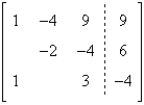
B)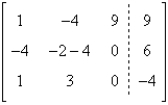
C)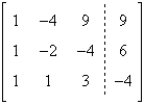
D)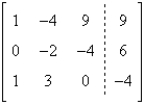
E)

A)

B)

C)

D)

E)


Unlock Deck
Unlock for access to all 150 flashcards in this deck.
Unlock Deck
k this deck
18
An airplane flying into a headwind travels 690 miles in 3 hours and 50 minutes. On the return flight, the distance is traveled in 3 hours. Find the airspeed of the plane and the speed of the wind, assuming that both remain constant.
A) plane speed = 220 mph; wind speed = 25 mph
B) plane speed = 182 mph; wind speed = 194 mph
C) plane speed = 205 mph; wind speed = 25 mph
D) plane speed = 220 mph; wind speed = 212 mph
E) plane speed = 182 mph; wind speed = 25 mph
A) plane speed = 220 mph; wind speed = 25 mph
B) plane speed = 182 mph; wind speed = 194 mph
C) plane speed = 205 mph; wind speed = 25 mph
D) plane speed = 220 mph; wind speed = 212 mph
E) plane speed = 182 mph; wind speed = 25 mph

Unlock Deck
Unlock for access to all 150 flashcards in this deck.
Unlock Deck
k this deck
19
Determine which one of the ordered triples below is a solution of the given system of equations. 
A)
B)
C)
D)
E)

A)

B)

C)

D)

E)


Unlock Deck
Unlock for access to all 150 flashcards in this deck.
Unlock Deck
k this deck
20
Find the equation of the circle  that passes through the points
that passes through the points  .
.
A)
B)
C)
D)
E)
 that passes through the points
that passes through the points  .
.A)

B)

C)

D)

E)


Unlock Deck
Unlock for access to all 150 flashcards in this deck.
Unlock Deck
k this deck
21
Write the augmented matrix for the system of linear equations. 
A)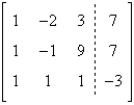
B)
C)
D)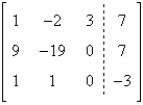
E)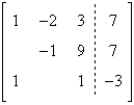

A)

B)

C)

D)

E)


Unlock Deck
Unlock for access to all 150 flashcards in this deck.
Unlock Deck
k this deck
22
During one performance of a local arts council's presentation of Fiddler on the Roof, the box office sold 218 tickets and collected $1410. If adult tickets sold for $7 and children's tickets sold for $6, how many of each type of ticket were sold?
A) adult tickets sold = 80; children's tickets sold = 141
B) adult tickets sold = 94; children's tickets sold = 80
C) adult tickets sold = 102; children's tickets sold = 116
D) adult tickets sold = 116; children's tickets sold = 102
E) adult tickets sold = 80; children's tickets sold = 94
A) adult tickets sold = 80; children's tickets sold = 141
B) adult tickets sold = 94; children's tickets sold = 80
C) adult tickets sold = 102; children's tickets sold = 116
D) adult tickets sold = 116; children's tickets sold = 102
E) adult tickets sold = 80; children's tickets sold = 94

Unlock Deck
Unlock for access to all 150 flashcards in this deck.
Unlock Deck
k this deck
23
Solve the system by the method of elimination. 
A) inconsistent
B)
C)
D)
E)

A) inconsistent
B)

C)

D)

E)


Unlock Deck
Unlock for access to all 150 flashcards in this deck.
Unlock Deck
k this deck
24
Use matrices to solve the system of equations (if possible). Use Gaussian elimination with back-substitution or Gauss-Jordan elimination. 
A) x = 5, y = -2, z = -6
B) x = 2, y = -5, z = 6
C) x = -2, y = -5, z = 6
D) no solution
E) x = 2, y = 5, z = 6

A) x = 5, y = -2, z = -6
B) x = 2, y = -5, z = 6
C) x = -2, y = -5, z = 6
D) no solution
E) x = 2, y = 5, z = 6

Unlock Deck
Unlock for access to all 150 flashcards in this deck.
Unlock Deck
k this deck
25
Determine which one of the ordered triples below is a solution of the given system of equations. 
A)
B)
C)
D)
E)

A)

B)

C)

D)

E)


Unlock Deck
Unlock for access to all 150 flashcards in this deck.
Unlock Deck
k this deck
26
Find the equilibrium point of the demand and supply equations. (The equilibrium point is the price p and number of units x that satisfy both the demand and supply equations.) Demand
Supply

A)
B) inconsistent
C)
D)
E)
Supply


A)

B) inconsistent
C)

D)

E)


Unlock Deck
Unlock for access to all 150 flashcards in this deck.
Unlock Deck
k this deck
27
An object moving vertically is at the given heights at the specified times. Find the position equation  for the object. At t = 1 second, s = 284 feet
for the object. At t = 1 second, s = 284 feet
At t = 2 seconds, s = 221 feet
At t = 3 seconds, s = 126 feet
A)
B)
C)
D)
E)
 for the object. At t = 1 second, s = 284 feet
for the object. At t = 1 second, s = 284 feetAt t = 2 seconds, s = 221 feet
At t = 3 seconds, s = 126 feet
A)

B)

C)

D)

E)


Unlock Deck
Unlock for access to all 150 flashcards in this deck.
Unlock Deck
k this deck
28
An airplane flying into a headwind travels 432 miles in 3 hours and 36 minutes. On the return flight, the distance is traveled in 3 hours. Find the airspeed of the plane and the speed of the wind, assuming that both remain constant.
A) plane speed = 147 mph; wind speed = 12 mph
B) plane speed = 109 mph; wind speed = 12 mph
C) plane speed = 109 mph; wind speed = 121 mph
D) plane speed = 147 mph; wind speed = 139 mph
E) plane speed = 132 mph; wind speed = 12 mph
A) plane speed = 147 mph; wind speed = 12 mph
B) plane speed = 109 mph; wind speed = 12 mph
C) plane speed = 109 mph; wind speed = 121 mph
D) plane speed = 147 mph; wind speed = 139 mph
E) plane speed = 132 mph; wind speed = 12 mph

Unlock Deck
Unlock for access to all 150 flashcards in this deck.
Unlock Deck
k this deck
29
Determine whether the matrix is in row-echelon form. If it is, determine if it is also in reduced row-echelon form. 
A) row-echelon form and reduced row-echelon form
B) row-echelon form
C) neither

A) row-echelon form and reduced row-echelon form
B) row-echelon form
C) neither

Unlock Deck
Unlock for access to all 150 flashcards in this deck.
Unlock Deck
k this deck
30
Find the determinant of  .
.
A) 14
B) 7
C) -8
D) 6
E) 12
 .
.A) 14
B) 7
C) -8
D) 6
E) 12

Unlock Deck
Unlock for access to all 150 flashcards in this deck.
Unlock Deck
k this deck
31
Use Cramer's Rule to solve the following system of linear equations: 
A)
B)
C)
D)
E)

A)

B)

C)

D)

E)


Unlock Deck
Unlock for access to all 150 flashcards in this deck.
Unlock Deck
k this deck
32
Applying Kirchhoff's Laws to the electrical network in the figure, the currents I1, I2, and I3 are the solution of the system  Find the currents.
Find the currents. 

A)


B)


C)


D)


E)


 Find the currents.
Find the currents. 

A)



B)



C)



D)



E)




Unlock Deck
Unlock for access to all 150 flashcards in this deck.
Unlock Deck
k this deck
33
Find the inverse of the matrix  (if it exists).
(if it exists).
A)
B)
C) does not exist
D)
E)
 (if it exists).
(if it exists).A)

B)

C) does not exist
D)

E)


Unlock Deck
Unlock for access to all 150 flashcards in this deck.
Unlock Deck
k this deck
34
Find the equation of the circle  that passes through the points
that passes through the points  .
.
A)
B)
C)
D)
E)
 that passes through the points
that passes through the points  .
.A)

B)

C)

D)

E)


Unlock Deck
Unlock for access to all 150 flashcards in this deck.
Unlock Deck
k this deck
35
Solve the system by the method of substitution. 
A) (-4, 2)
B) (2, -4)
C) (-2, -4)
D) (-4, -2)
E) (4, 2)

A) (-4, 2)
B) (2, -4)
C) (-2, -4)
D) (-4, -2)
E) (4, 2)

Unlock Deck
Unlock for access to all 150 flashcards in this deck.
Unlock Deck
k this deck
36
Solve for x given the following equation involving a determinant. 
A)
B)
C)
D)
E)

A)

B)

C)

D)

E)


Unlock Deck
Unlock for access to all 150 flashcards in this deck.
Unlock Deck
k this deck
37
Find the sales necessary to break even (R - C = 0) for the cost C of producing x units and the revenue R obtained by selling x units. (Round to the nearest whole unit.) 
A) 904 units
B) 837 units
C) 837 units or 904 units
D) no real solution
E) 882 units

A) 904 units
B) 837 units
C) 837 units or 904 units
D) no real solution
E) 882 units

Unlock Deck
Unlock for access to all 150 flashcards in this deck.
Unlock Deck
k this deck
38
Solve using any method. 
A)
B)
C)
D)
E) inconsistent

A)

B)

C)

D)

E) inconsistent

Unlock Deck
Unlock for access to all 150 flashcards in this deck.
Unlock Deck
k this deck
39
Solve using any method. 
A)
B)
C)
D) inconsistent
E)

A)

B)

C)

D) inconsistent
E)


Unlock Deck
Unlock for access to all 150 flashcards in this deck.
Unlock Deck
k this deck
40
Find the determinant of the matrix  .
.
A)
B)
C)
D)
E)
 .
.A)

B)

C)

D)

E)


Unlock Deck
Unlock for access to all 150 flashcards in this deck.
Unlock Deck
k this deck
41
Solve the system by the method of elimination. 
A)
B)
C)
D)
E) inconsistent

A)

B)

C)

D)

E) inconsistent

Unlock Deck
Unlock for access to all 150 flashcards in this deck.
Unlock Deck
k this deck
42
Solve for x given the following equation involving a determinant. 
A)
B)
C)
D)
E)

A)

B)

C)

D)

E)


Unlock Deck
Unlock for access to all 150 flashcards in this deck.
Unlock Deck
k this deck
43
Evaluate the expression. 
A)
B)
C) not possible
D)
E)

A)

B)

C) not possible
D)

E)


Unlock Deck
Unlock for access to all 150 flashcards in this deck.
Unlock Deck
k this deck
44
Use Cramer's Rule to solve the following system of linear equations: 
A)
B)
C)
D)
E)

A)

B)

C)

D)

E)


Unlock Deck
Unlock for access to all 150 flashcards in this deck.
Unlock Deck
k this deck
45
Find the determinant of  .
.
A) -828
B) 512
C) -768
D) -736
E) -64
 .
.A) -828
B) 512
C) -768
D) -736
E) -64

Unlock Deck
Unlock for access to all 150 flashcards in this deck.
Unlock Deck
k this deck
46
Find the equilibrium point of the demand and supply equations. (The equilibrium point is the price p and number of units x that satisfy both the demand and supply equations.) Demand
Supply

A)
B)
C)
D)
E) inconsistent
Supply


A)

B)

C)

D)

E) inconsistent

Unlock Deck
Unlock for access to all 150 flashcards in this deck.
Unlock Deck
k this deck
47
Solve using any method. 
A)
B)
C)
D)
E) inconsistent

A)

B)

C)

D)

E) inconsistent

Unlock Deck
Unlock for access to all 150 flashcards in this deck.
Unlock Deck
k this deck
48
Determine which one of the ordered triples below is a solution of the given system of equations. 
A)
B)
C)
D)
E)

A)

B)

C)

D)

E)


Unlock Deck
Unlock for access to all 150 flashcards in this deck.
Unlock Deck
k this deck
49
Solve using any method. 
A)
B)
C)
D)
E) inconsistent

A)

B)

C)

D)

E) inconsistent

Unlock Deck
Unlock for access to all 150 flashcards in this deck.
Unlock Deck
k this deck
50
If possible, find 5A - 4B. 
A)
B) not possible
C)
D)
E)

A)

B) not possible
C)

D)

E)


Unlock Deck
Unlock for access to all 150 flashcards in this deck.
Unlock Deck
k this deck
51
Find the determinant of the matrix  .
.
A)
B)
C)
D)
E)
 .
.A)

B)

C)

D)

E)


Unlock Deck
Unlock for access to all 150 flashcards in this deck.
Unlock Deck
k this deck
52
Find the inverse of the matrix  (if it exists).
(if it exists).
A)
B)
C) does not exist
D)
E)
 (if it exists).
(if it exists).A)

B)

C) does not exist
D)

E)


Unlock Deck
Unlock for access to all 150 flashcards in this deck.
Unlock Deck
k this deck
53
During one performance of a local arts council's presentation of Fiddler on the Roof, the box office sold 200 tickets and collected $1372. If adult tickets sold for $8 and children's tickets sold for $6, how many of each type of ticket were sold?
A) adult tickets sold = 97; children's tickets sold = 125
B) adult tickets sold = 86; children's tickets sold = 114
C) adult tickets sold = 114; children's tickets sold = 86
D) adult tickets sold = 125; children's tickets sold = 97
E) adult tickets sold = 97; children's tickets sold = 99
A) adult tickets sold = 97; children's tickets sold = 125
B) adult tickets sold = 86; children's tickets sold = 114
C) adult tickets sold = 114; children's tickets sold = 86
D) adult tickets sold = 125; children's tickets sold = 97
E) adult tickets sold = 97; children's tickets sold = 99

Unlock Deck
Unlock for access to all 150 flashcards in this deck.
Unlock Deck
k this deck
54
If possible, find AB. 
A) not possible
B)
C)
D)
E)

A) not possible
B)

C)

D)

E)


Unlock Deck
Unlock for access to all 150 flashcards in this deck.
Unlock Deck
k this deck
55
The currents in an electrical network are given by the solutions of the system  where I1, I2, and I3 are measured in amperes. Solve the system of equations using matrices.
where I1, I2, and I3 are measured in amperes. Solve the system of equations using matrices.
A) I1 = 4, I2 = 5, I3 = 9
B) I1 = 2, I2 = 3, I3 = 6
C) I1 = 2, I2 = 3, I3 = 5
D) I1 = 4, I2 = 9, I3 = 5
E) no solution
 where I1, I2, and I3 are measured in amperes. Solve the system of equations using matrices.
where I1, I2, and I3 are measured in amperes. Solve the system of equations using matrices.A) I1 = 4, I2 = 5, I3 = 9
B) I1 = 2, I2 = 3, I3 = 6
C) I1 = 2, I2 = 3, I3 = 5
D) I1 = 4, I2 = 9, I3 = 5
E) no solution

Unlock Deck
Unlock for access to all 150 flashcards in this deck.
Unlock Deck
k this deck
56
Find the sales necessary to break even (R - C = 0) for the cost C of producing x units and the revenue R obtained by selling x units. (Round to the nearest whole unit.) 
A) 782 units
B) 782 units or 852 units
C) 852 units
D) 831 units
E) no real solution

A) 782 units
B) 782 units or 852 units
C) 852 units
D) 831 units
E) no real solution

Unlock Deck
Unlock for access to all 150 flashcards in this deck.
Unlock Deck
k this deck
57
An airplane flying into a headwind travels 216 miles in 2 hours and 42 minutes. On the return flight, the distance is traveled in 2 hours. Find the airspeed of the plane and the speed of the wind, assuming that both remain constant.
A) plane speed = 109 mph; wind speed = 101 mph
B) plane speed = 109 mph; wind speed = 14 mph
C) plane speed = 71 mph; wind speed = 83 mph
D) plane speed = 71 mph; wind speed = 14 mph
E) plane speed = 94 mph; wind speed = 14 mph
A) plane speed = 109 mph; wind speed = 101 mph
B) plane speed = 109 mph; wind speed = 14 mph
C) plane speed = 71 mph; wind speed = 83 mph
D) plane speed = 71 mph; wind speed = 14 mph
E) plane speed = 94 mph; wind speed = 14 mph

Unlock Deck
Unlock for access to all 150 flashcards in this deck.
Unlock Deck
k this deck
58
Evaluate the expression. 
A)
B)
C)
D)
E) not possible

A)

B)

C)

D)

E) not possible

Unlock Deck
Unlock for access to all 150 flashcards in this deck.
Unlock Deck
k this deck
59
An object moving vertically is at the given heights at the specified times. Find the position equation  for the object. At t = 1 second, s = 161 feet
for the object. At t = 1 second, s = 161 feet
At t = 2 seconds, s = 98 feet
At t = 3 seconds, s = 3 feet
A)
B)
C)
D)
E)
 for the object. At t = 1 second, s = 161 feet
for the object. At t = 1 second, s = 161 feetAt t = 2 seconds, s = 98 feet
At t = 3 seconds, s = 3 feet
A)

B)

C)

D)

E)


Unlock Deck
Unlock for access to all 150 flashcards in this deck.
Unlock Deck
k this deck
60
Solve the system by the method of substitution. 
A) (4, 3)
B) (-3, 4)
C) (3, 4)
D) (4, -3)
E) (-4, 3)

A) (4, 3)
B) (-3, 4)
C) (3, 4)
D) (4, -3)
E) (-4, 3)

Unlock Deck
Unlock for access to all 150 flashcards in this deck.
Unlock Deck
k this deck
61
Solve the system of equations by graphing. 
A) (-4, 6)
B) (-5, 5)
C) (6, 1)
D) (5, -5)
E) (3, 13)

A) (-4, 6)
B) (-5, 5)
C) (6, 1)
D) (5, -5)
E) (3, 13)

Unlock Deck
Unlock for access to all 150 flashcards in this deck.
Unlock Deck
k this deck
62
Find the determinant of the matrix  .
.
A)
B)
C)
D)
E)
 .
.A)

B)

C)

D)

E)


Unlock Deck
Unlock for access to all 150 flashcards in this deck.
Unlock Deck
k this deck
63
Evaluate the expression. 
A)
B)
C)
D)
E) not possible

A)

B)

C)

D)

E) not possible

Unlock Deck
Unlock for access to all 150 flashcards in this deck.
Unlock Deck
k this deck
64
If possible, find AB. 
A)
B)
C)
D)
E) not possible

A)

B)

C)

D)

E) not possible

Unlock Deck
Unlock for access to all 150 flashcards in this deck.
Unlock Deck
k this deck
65
Evaluate the expression. 
A)
B)
C)
D)
E) not possible

A)

B)

C)

D)

E) not possible

Unlock Deck
Unlock for access to all 150 flashcards in this deck.
Unlock Deck
k this deck
66
Solve the system. 
A)
B)
C)
D)
E) no solution

A)

B)

C)

D)

E) no solution

Unlock Deck
Unlock for access to all 150 flashcards in this deck.
Unlock Deck
k this deck
67
If possible, find 2A - 5B. 
A)
B)
C)
D)
E) not possible

A)

B)

C)

D)

E) not possible

Unlock Deck
Unlock for access to all 150 flashcards in this deck.
Unlock Deck
k this deck
68
Find the inverse of the matrix  (if it exists).
(if it exists).
A)
B)
C)
D)
E) does not exist
 (if it exists).
(if it exists).A)

B)

C)

D)

E) does not exist

Unlock Deck
Unlock for access to all 150 flashcards in this deck.
Unlock Deck
k this deck
69
Determine whether the matrix is in row-echelon form. If it is, determine if it is also in reduced row-echelon form. 
A) row-echelon form
B) row-echelon form and reduced row-echelon form
C) neither

A) row-echelon form
B) row-echelon form and reduced row-echelon form
C) neither

Unlock Deck
Unlock for access to all 150 flashcards in this deck.
Unlock Deck
k this deck
70
Applying Kirchhoff's Laws to the electrical network in the figure, the currents I1, I2, and I3 are the solution of the system  Find the currents.
Find the currents. 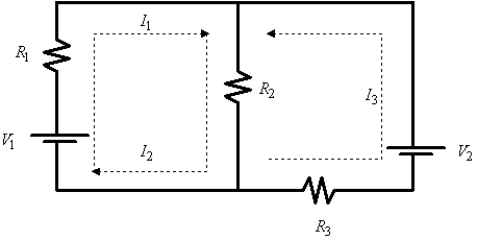

A)


B)


C)


D)


E)


 Find the currents.
Find the currents. 

A)



B)



C)



D)



E)




Unlock Deck
Unlock for access to all 150 flashcards in this deck.
Unlock Deck
k this deck
71
Solve for x given the following equation involving a determinant. 
A)
B)
C)
D)
E)

A)

B)

C)

D)

E)


Unlock Deck
Unlock for access to all 150 flashcards in this deck.
Unlock Deck
k this deck
72
Find the equation of the circle  that passes through the points
that passes through the points  .
.
A)
B)
C)
D)
E)
 that passes through the points
that passes through the points  .
.A)

B)

C)

D)

E)


Unlock Deck
Unlock for access to all 150 flashcards in this deck.
Unlock Deck
k this deck
73
Use matrices to solve the system of equations (if possible). Use Gaussian elimination with back-substitution or Gauss-Jordan elimination. 
A) x = -5, y = -3, z = 2
B) x = 5, y = -3, z = 2
C) x = 5, y = 3, z = 2
D) x = 3, y = -5, z = -2
E) no solution

A) x = -5, y = -3, z = 2
B) x = 5, y = -3, z = 2
C) x = 5, y = 3, z = 2
D) x = 3, y = -5, z = -2
E) no solution

Unlock Deck
Unlock for access to all 150 flashcards in this deck.
Unlock Deck
k this deck
74
Find the determinant of  .
.
A) 14
B) 7
C) 12
D) -8
E) 6
 .
.A) 14
B) 7
C) 12
D) -8
E) 6

Unlock Deck
Unlock for access to all 150 flashcards in this deck.
Unlock Deck
k this deck
75
Write the augmented matrix for the system of linear equations. 
A)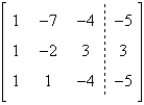
B)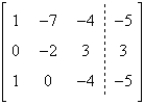
C)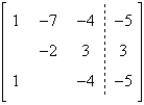
D)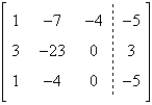
E)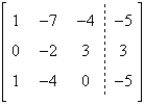

A)

B)

C)

D)

E)


Unlock Deck
Unlock for access to all 150 flashcards in this deck.
Unlock Deck
k this deck
76
Determine which ordered pair is a solution of the system. 
A) (-3, 6)
B) (-1, -2)
C) (-2, -1)
D) (1, -2)
E) (6, 3)

A) (-3, 6)
B) (-1, -2)
C) (-2, -1)
D) (1, -2)
E) (6, 3)

Unlock Deck
Unlock for access to all 150 flashcards in this deck.
Unlock Deck
k this deck
77
The currents in an electrical network are given by the solutions of the system  where I1, I2, and I3 are measured in amperes. Solve the system of equations using matrices.
where I1, I2, and I3 are measured in amperes. Solve the system of equations using matrices.
A) I1 = 5, I2 = 8, I3 = 3
B) I1 = 5, I2 = 3, I3 = 8
C) I1 = 3, I2 = 5, I3 = 9
D) I1 = 3, I2 = 5, I3 = 8
E) no solution
 where I1, I2, and I3 are measured in amperes. Solve the system of equations using matrices.
where I1, I2, and I3 are measured in amperes. Solve the system of equations using matrices.A) I1 = 5, I2 = 8, I3 = 3
B) I1 = 5, I2 = 3, I3 = 8
C) I1 = 3, I2 = 5, I3 = 9
D) I1 = 3, I2 = 5, I3 = 8
E) no solution

Unlock Deck
Unlock for access to all 150 flashcards in this deck.
Unlock Deck
k this deck
78
Solve the system by substitution, if possible. 
A) (4, 8)
B) (8, 4)
C) (-4, 13)
D) (12, -3)
E) no solutions

A) (4, 8)
B) (8, 4)
C) (-4, 13)
D) (12, -3)
E) no solutions

Unlock Deck
Unlock for access to all 150 flashcards in this deck.
Unlock Deck
k this deck
79
Determine which ordered pair is a solution of the system. 
A) (8, 1)
B) (-9, 3)
C) (-9,8)
D) (8, -1)
E) (1, -8)

A) (8, 1)
B) (-9, 3)
C) (-9,8)
D) (8, -1)
E) (1, -8)

Unlock Deck
Unlock for access to all 150 flashcards in this deck.
Unlock Deck
k this deck
80
Use Cramer's Rule to solve the following system of linear equations: 
A)
B)
C)
D)
E)

A)

B)

C)

D)

E)


Unlock Deck
Unlock for access to all 150 flashcards in this deck.
Unlock Deck
k this deck



